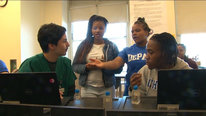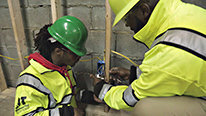- Regina Werum
- Professor
- Collaborative Research: Soldiers to Citizens ... to Scientists? How Military Service Shapes STEM Trajectories
- University of Nebraska-Lincoln
- Christina Steidl
- Associate Professor
- Collaborative Research: Soldiers to Citizens ... to Scientists? How Military Service Shapes STEM Trajectories
- University of Alabama Huntsville
Collaborative Research: Soldiers to Citizens ... to Scientists? How Military...
This project explores the role of the U.S. military as a potential pathway into STEM degrees and occupations. Specifically, it addresses the following questions central to research on STEM education and occupations: How does military service (and the educational benefits associated with it) shape individuals’ training and employment in STEM fields? To what extent do on-the-job experiences associated with specific military assignments facilitate STEM trajectories? And to what extent do those selection and exposure dynamics create gendered trajectories into STEM fields? Finally, to what extent do competing definitions of STEM employed by federal agencies affect the patterns we see regarding STEM-related educational and occupational outcomes? To answer these questions, the project employs statistical analysis of publically available data from the American Community Survey (ACS), combined with other secondary data. More broadly speaking, the project addresses recurrent calls to increase the number of STEM professionals, diversify the STEM workforce, and optimize the recruitment of military personnel into STEM professions. In addition to helping researchers identify the effects of existing policies and initiatives designed to foster recruitment into STEM fields, findings point to untapped leverage that can be used to further broaden STEM participation.
Collaborative Research: Soldiers to Citizens ... to Scientists? How Military...
This project explores the role of the U.S. military as a potential pathway into STEM degrees and occupations. Specifically, it addresses the following questions central to research on STEM education and occupations: How does military service (and the educational benefits associated with it) shape individuals’ training and employment in STEM fields? To what extent do on-the-job experiences associated with specific military assignments facilitate STEM trajectories? And to what extent do those selection and exposure dynamics create gendered trajectories into STEM fields? Finally, to what extent do competing definitions of STEM employed by federal agencies affect the patterns we see regarding STEM-related educational and occupational outcomes? To answer these questions, the project employs statistical analysis of publically available data from the American Community Survey (ACS), combined with other secondary data. More broadly speaking, the project addresses recurrent calls to increase the number of STEM professionals, diversify the STEM workforce, and optimize the recruitment of military personnel into STEM professions. In addition to helping researchers identify the effects of existing policies and initiatives designed to foster recruitment into STEM fields, findings point to untapped leverage that can be used to further broaden STEM participation.
-
 Stereotypes about Brilliance Are a Barrier to STEM Diversity
Stereotypes about Brilliance Are a Barrier to STEM Diversity
Andrei Cimpian
-
 Chicago Geospatial Semester Project
Chicago Geospatial Semester Project
Katie James
-
 Lessons Learned from Launching High School Manufacturing App
Lessons Learned from Launching High School Manufacturing App
Matthew Fieldman
-
 Building a Diverse STEM Talent Pipeline: Finding What Works
Building a Diverse STEM Talent Pipeline: Finding What Works
Tracey Hall
-
 NSF LSAMP Bridge to the Doctorate - U of Illinois at Chicago
NSF LSAMP Bridge to the Doctorate - U of Illinois at Chicago
Denise Yates
-
 NYSCI Neighbors Science Ambassadors Program
NYSCI Neighbors Science Ambassadors Program
Andres Henriquez
4494 Views
Continue the discussion of this presentation on the Multiplex. Go to Multiplex
4494 Views
presentation
has been viewed
Related videos you might be interested in...
-
 Stereotypes about Brilliance Are a Barrier to STEM Diversity
Stereotypes about Brilliance Are a Barrier to STEM Diversity
Andrei Cimpian
-
 Chicago Geospatial Semester Project
Chicago Geospatial Semester Project
Katie James
-
 Lessons Learned from Launching High School Manufacturing App
Lessons Learned from Launching High School Manufacturing App
Matthew Fieldman
-
 Building a Diverse STEM Talent Pipeline: Finding What Works
Building a Diverse STEM Talent Pipeline: Finding What Works
Tracey Hall
-
 NSF LSAMP Bridge to the Doctorate - U of Illinois at Chicago
NSF LSAMP Bridge to the Doctorate - U of Illinois at Chicago
Denise Yates
-
 NYSCI Neighbors Science Ambassadors Program
NYSCI Neighbors Science Ambassadors Program
Andres Henriquez


Christina Steidl
Associate Professor
Thank you for watching our video about how military service may serve as an alternate pathway into STEM education and careers, especially for women. Having completed our initial statistical analyses, we are now conducting follow-up analyses related to G.I. Bill funding and other factors that may influence the military-STEM relationship. One challenge to this project has been locating datasets with substantial numbers of female veterans, so we would be particularly interested in hearing about the datasets employed by other researchers. We are also interested in hearing about university or human resources efforts targeted at recruiting military veterans into STEM programs and fields.
Sarah Haavind
Senior Research Project Manager
Christina, I jut learned about a new dataset search engine to help scientists find the datasets they need. Here is the article - perhaps it will be useful! ~Sarah
Christina Steidl
Regina Werum
Professor
Sarah,
Thank you for sharing! Regina
Brian Drayton
Hi,
Given your narrative about the relatively hgher proportion of veterans vs nonveterans engaging in the STEM workforce, I was surprised by the conclusion of the video, identifying the military as an "untapped resource." What would tapping it look like?
Also, do you have data on whether there is a difference in which fields veterans vs nonveterans enter?
Thanks!
Christina Steidl
Associate Professor
Dear Brian,
Excellent question, thanks for following up. It is true that veterans disproportionately enter STEM fields – what our research shows is that this is particularly true for women veterans, across racial groups. By “untapped” we mean that this is a unique opportunity for STEM fields
to purposefully recruit with the goal to diversify their workforce along gender and racial lines. In other words, rather than leaving up to chance alone which veterans make it into STEM fields, employers could purposefully recruit from military personnel with the goal to diversify the STEM workforce for those with and without college degrees. Moreover, while our research shows that military service helps narrow the gender gap in STEM fields, it does not eliminate it. This is an opportunity for the military to purposefully recruit women into all ranks and all STEM related experiences – with the potential down-stream benefit for reducing gaps and shortages in the civilian STEM workforce. In other words, imagine what the STEM workforce could look like if there were a concerted effort to recruit and retain women into a broad range of STEM fields via military service.
Regina & Christina
Rebecca Roberts
Thanks for sharing-while I have mentored students in college about how to use their STEM degrees in the military, this is a new perspective. Is there information on how these students are being recruited into four-year colleges after their military service
Christina Steidl
Associate Professor
Great question, we are in the process of asking for information from experts in the field. The ACS data used in our analyses does not address this issue directly, and we are not aware of any specific source containing systematic information on this matter across institutions (please share if you do?). It appears there is significant variation in institutional recruitment and retention practices, even among similar institutions (e.g., Big 10, or APLU). This raises a series of questions: What types of institutions have a recruitment program in place – and post recruitment, how do they perform on retention/completion?
Our preliminary sense of the situation is that some institutions excel at recruiting active military personnel for online programs -- but retention is notoriously lower for those than for in-person programs. Other institutions may excel at recruiting veterans -- but their needs and profiles are significantly different from those who are current/active-duty personnel. In other words, the basic designation of a “yellow ribbon” (aka military-friendly) institution masks underlying complexities shaping recruitment and retention strategies. Does this help?
Rebecca Roberts
Rebecca Roberts
Yes, thank you.
Irene Ngun
Thank you for sharing your work! This is such an important and timely study. It seems like much of the existing research focuses on four year institutions and alternative pathways have been largely overlooked. Could you point to some specific examples academic STEM disciplines can learn from the military in terms of recruiting and retaining women in STEM?
Christina Steidl
Associate Professor
Answering this question would require us to extrapolate beyond our particular study. What we know, broadly speaking, is that these effects are caused by a combination of selection into and retention in the military and in these STEM fields.
One of the strongest predictors of joining the US military is being a working-class high-school graduate or “first-gen” college
student, many of whom come from historically underrepresented groups. The military has excelled in diversifying its ranks (if not its officer corps), especially in the Army, in part by providing recruits with benefits (“GI Bill”). In contrast, we know that postsecondary institutions often charge extra fees for students recruited into engineering and/or computer science colleges/programs/courses. It is possible that these extra fees inadvertently dissuade working-class students and women from entering these particularly STEM fields.
With respect to retention, we can confidently point to a large body of extant research that identifies best practices for retaining marginalized student groups, regardless of the field. These practices include e.g., matching students with mentors with whom they can identify (this goes beyond race/sex matching), providing a cohort/unit/community experience (e.g., via housing, extracurricular
engagement), and restructuring intro courses in ways that help tether these students to the field, rather than “weed them out.” This is particularly effective for students whose level of confidence is lower than their actual level of competence (significant research shows a gendered and racialized mismatch between those two concepts).
Best,
Regina & Christina
Christina Steidl
Associate Professor
Our colleague, Jacob adds:
One example would be two conferences that U.S. Army (and other services) partner with industry to highlight the opportunities for STEM career including Black Engineer of the Year and Women of Color STEM conferences. These are huge events with hundreds of officers and undergraduate ROTC & service academy students participating.
BEYA STEM Conference (https://intouch.ccgmag.com/page/beya_stem_conf2)
WOC STEM Conference (https://intouch.ccgmag.com/page/woc_conference2)
All the service academies and ROTC programs are actively working to recruit diverse faculty and professors of military science (i.e., women and minorities) to serve as recruiters and mentors (to retain) junior officers early in their career.
The Air Force & Navy are more technical skills driven occupations with more deliberate recruiting programs for STEM fields.
Major Jacob Absalon, Project Team Member
Karen Mutch-Jones
Senior Researcher
Moving into civilian life/work after military service can be challenging, and so your description about this pathway into STEM careers was encouraging. I was especially interested in your finding that women with military experience are 41% more likely to earn a STEM degree than civilian women. This led me to wonder what else we might learn from this or similar groups. For instance, were there common types of experiences or opportunities that these women had while in the military that shaped their decision to get a STEM degree? What types of jobs in STEM did women obtain after military service, and did this differ in any substantial ways from the jobs that men obtained? Are there ways to help women transition into STEM careers?
Thank you for sharing your project research and statistics.
Christina Steidl
Associate Professor
These are excellent questions. What types of jobs in STEM did women obtain after military service, and did this differ in any substantial ways from the jobs that men obtained? The next stage of our analysis involves disaggregating STEM fields, to analyze whether female veterans are more likely to earn degrees or be employed in particular STEM occupations. Our preliminary analyses suggest that a substantial number of female veterans are entering biological/health science fields, but we are still evaluating the extent to which these patterns differ from female civiliansor male veterans. In addition, we are looking into the extent to which earning a STEM degree is coupled to actually working in STEM occupations, again comparing the experiences of various groups.
Were there common types of experiences or opportunities that these women had while in the military that shaped their decision to get a STEM degree? Unfortunately, our data has very limited information about individuals’ experiences in the military– essentially we know that they served and when they served. As noted in one of our other responses above, it makes sense to assume that military service influences both subsequent selection into STEM fields and retention/graduation in those fields, but due to ACS data limitations we are unable to test the particular mechanisms (e.g., certain experiences or opportunities encountered while serving in the military) driving this relationship. We are looking for additional datasets that may contain this type of information, but often the very small number of female veterans in these more detailed datasets precludes such analyses. Are you aware of any available dataset that we might ue to address this question?
Regarding your final question – we outline a few potential strategies that are known to work during the training phase (best practices like mentors etc.), but it is quite likely that the specific interventions most likely to work will depend on the type of organization/career and STEM field. For example academic vs. corporate vs. public service; lab-based vs. field-based vs. applied sciences. Does this help?
Karen Mutch-Jones
Senior Researcher
Thank you, Christina, for your detailed response. I saw a NSF report suggesting that women in STEM tend to enter health science fields (more than men), so it makes sense that might happen as well for women veterans. Adding the STEM degree component to your analysis could definitely shed a more complex light on trends. I'm glad to know that you are analyzing the data further, since there is more to learn.
Too bad there isn't more data about women's STEM experiences while in the military. Knowing more about this might inform colleges about the skills, abilities, and needs of female veterans who are entering their programs following their military service. Since it isn't available via public datasets, maybe a future study can include a research component where you collect survey and/or interview data from women who have recently completed their time in the military and entered STEM programs or jobs? I'm only suggesting because I think that what you learn could really influence women's opportunities in STEM, which is especially important for those who don't have a college degree when they leave the service!
Best wishes with your project and study.
Sarah Haavind
Senior Research Project Manager
Christina, thank you for sharing so many insights here along with the video on your intriguing project. I agree with Karen that there is a potential argument for an extension to your project in a survey of women who have recently completed their tour of duty. Is there a lot of exposure to high tech jobs and roles across military service assignments? In another project, Helping Today's Students Find Their Place, the PI mentions a difficulty for women is imagining what a computer professional does. In the military, there is likely lots of experience seeing computer professionals at work, or learning the skills as part of service. Perhaps simple exposure has a positive affect. Another possibility is how so much of military service is done as part of a team, and everyone counts on everyone else to do their job. Do you think that collaborative element is what makes the otherwise more "geeky" STEM work more meaningful for women who experience it in the military? Now I'm really curious! Having thought about it so much, what do you think is drawing that extra percentage of post-military women into STEM? (I wish I had some datasets for you! Good luck in your quest.)
Regina Werum
Professor
Sarah,
You are probably right -- we also suspect that both selection and exposure effects are creating these patterns. The ACS data do not speak directly to this issue, leaving us to speculate rather than test e.g., the relative impact of either selection (into the military) or exposure to SYTEM (while in the military). And if exposure -- what is the mechanism -- is it the team-based approach, is it the practical/hands-on aspects, is it the modelling by peers, is it the length of exposure or multiple types of exposure to STEM, is it the specific content of the STEM field to which they are exposed (e.g., medicine vs. CS or Eng)? Unfortunately, we can't provide a concrete answer to your final question based on these analyses. We share your curiosity -- let us hope we can convince NSF to fund a follow-up project that helps identify the processes creating these patterns. :) Regina
Sarah Haavind
Joseph Provost
I am glad you are doing this project. I am both a chair of a chem and biochem dept and a veteran/first gen. Joining the Army out of high school (enlisted MP) then eventually becoming an officer (NBC and INF Corps) was influential in gaining the skills nessesary for success as a chem major and in life.
Do you find enlisted personnel (your officers will of course, already have college degrees) need some additional or retraining as they are a few years out from the math skills so critical for success in STEM?
Regina Werum
Professor
Joseph,
Great question, and the answer is probably yes. In large part because enlisted personnel essentially are nontraditional students – older, often with families and jobs to juggle alongside college, while earning a BA. The officers were fill-time students while being training and rather homogenous in terms of age and life course events. Many of the interventions aimed at helping other nontraditional students (e.g., students with day care needs, or health problems or fist-gen) should help those who are veterans as well. At the same time, we seem to see active-duty personnel in college (e.g., Nat Guard) struggle with a unique set of complications, including being deployed in the middle of a semester etc. The drawbacks of this practice go beyond an interrupted education (even if the GI funds are reimbursed), as many STEM degrees require courses to be taken in sequence. Flexibility on the part of academic institutions as well as the military would go a long way in re-acclimating students when they return. What suggestions do you have?
Joseph Provost
One of the issues (not specifically transition) is getting vets through a degree in the timeframe needed to remain eligible for the VA benefits. Close advising and perhaps, like some universities do for athletes, preferred early registration helps.
But I would think some sort of engagement in a research project that helps them refresh their study / cognitive skills the summer before they start would be really helpful. The way we learn in the military is not always helpful for the civilian world. So just an update on how to actively study, the learning skills needed to be successful is really good.
Regina Werum
Professor
Joseph, these are great suggestions. I will make sure to share these with our Mil/Vet Success Center. Do you know of a go-to place (or institution) that provides a broad set of suggestions on how to do this well, both re recruitment and retention/graduation on time?
Further posting is closed as the showcase has ended.